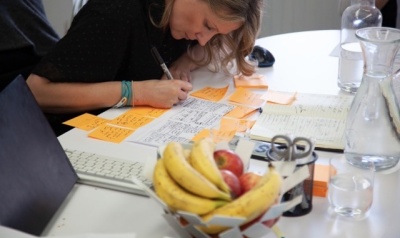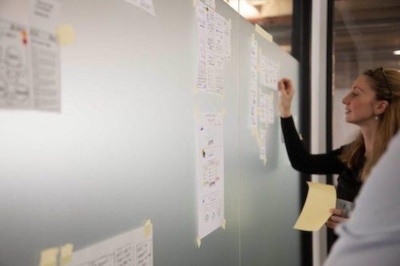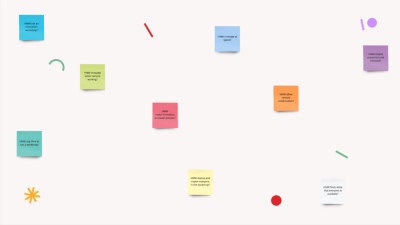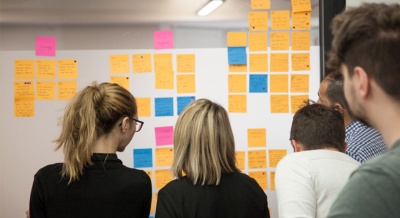Design Sprint Training

- Customer Experience
We’ve been running design sprints with clients for a while now. They are super rewarding, and you can get so much done, framed, prototyped, tested and validated in a week. It can feel empowering beyond its original purpose. The design sprint is also a great accelerator to help break silos within an organisation. Many of the teams we work with tell us that they wish that everyone in their company would get onboard with their favourite practices and processes. Unfortunately, it can sometimes feel like you and your team are from Venus, and the rest of the organisation is from Mars.
Don’t fret, while breaking silos is difficult and does require the building of long term relationships, it is possible to use the design sprint as a way of getting teams to collaborate. Practice running sprints, and you’ll soon have everyone working towards a common goal. Here are some of the hints and tips we’ve learned along our design sprint journey. We hope they’ll help you manage any curve balls that come up along the way.
How to convince the team & your organisation this is a good idea
1. Read Jake Knapp’s design sprint book.
(And share it with your team.) This sounds obvious, but there’s so much content out there, you might feel like you already know about design sprints. The book itself is easy and fun to read, just do it. You will quickly realise that most people follow the book and this will fill you with confidence to facilitate. (And you’ll get to find out how slack was created).
2. Start privately and run a sprint.
To start, pick a project that only impacts on your team/dept, so you don’t run into the issue of getting everyone to agree on a date and location. It will also help you understand the process properly. The best way to train for a design sprint is to run one. Then document and share the results of this with the rest of your organisation.
3. Show innovation through collaboration.
Make noise in your organisation. Design sprints are great way to make people both look at and engage with, your project. The reason for this is that you actually have something to show at the end of a sprint. It’s usually really impressive as you will have created a well-rounded output. You will have framed a problem, set a vision, looked at the competition, ideated, prototyped and tested. (So, in comparison to the usual long decks, you won’t have a strategy without KPIs or lots of research that is difficult to action.)

Before the Sprint
Prep, prep, and more prep
4. Only run the sprint if you can get the right people together.
Day 1, 2 and 3 absolutely requires people to be together. Prototyping and user testing can be optional, although it’s really fascinating and useful for everyone to observe users’ reactions. Book people in and make sure the decision makers will be present. If not, don’t run it.
This one is so important. I’ve run design sprints with people from very siloed departments that were blocking progress for each other. Day 1 was a little tense, but at the end of the week, they were collaborating and very much aligned. This was because everyone was heard and had a chance to input. That’s why design sprints are an excellent design thinking tool, they really generate creativity from the tension between desirability (UX), feasibility (Tech/Ops) and viability (Business).
5. Make it a great experience.
Make an event of the sprint. Create a little template deck you can reuse that explains what you want to solve, who is coming, why you are running this sprint and when it will take place. This will allow everyone to feel valued as experts but also give them extra confidence and trust in a framework that probably feels daunting or even suspicious in some cases. This is also a good time to gather any special requirements (vegan, other special requirements e.g. wheelchair access, immovable meetings, or other timing restrictions). This will get people excited, make them feel special and ensure things run smoothly.
6. Pick the right problem.
You need to know you’ve got a problem worth solving with a design sprint. This is the number 1 problem we’ve come across for all teams and organisations that want to enter a design sprint. There’s nothing more frustrating than to go into a sprint and realising halfway through that this isn’t a solid problem to solve.

During the sprint
7. Recap, recap, recap.
At the end of each day and beginning of every new day, recap on what was said. At the end of the day, it will help everyone realise how much they’ve done. At the beginning of the day, it will give everyone the opportunity to comment. People’s brains will carry on processing information long after the day is done and this is an excellent opportunity to capture that precious maturing of thoughts. Just make sure people stay on track, do it quickly and don’t move the goal posts.
8. Set guidelines.
Be super clear around the expectations for the sprint. Communicate, for example, that you might have to cut some conversations short because of time, and explain the rules of the game as well as timings.
9. Help people cultivate ideas.
As a facilitator, you should be able to help people cultivate ideas and identify highly emerging paths. Sprints are democratic, but you still need someone to help channel energy. Just like you will be helping people move on, you will also help them move on in the direction that is taking shape. Remember that this ‘isn’t your baby’. So don’t push your ideas and always refer to the decider to have the final say if people are getting stuck for too long on a particular subject.
10. Ask ‘What do we need to find out?’
Work with the team to identify the key things that need to be discovered during user testing. This will help everyone focus on the outcome but also gives you pillars for the discussion guide (script for user testing). Go back to your day one questions, and what you really want to learn so you don’t end up prototyping more than you can fit in a day.

After the sprint
11. Share a design sprint document across the business.
Create a beautiful document you can share within your organisation. It’s a great gift to all those that took part in the sprint to show and be proud of, and it will also assist the team with getting cross-functional buy-in for the project. Design sprints can create a feeling of ownership and strong bonds between people from different departments.
We hope these hints and tips have helped you on your way to running design sprints, a design sprint pushes you to move fast and lets users guide your decision making. It doesn’t have to be perfect in order to yield some beneficial results. If you would like to know more about our design sprint and design training services, get in touch for a chat.
If you want more on design sprints and enjoyed this post, our Creative Director Thomas Michalak has also created an ebook with 30 of his tips for running successful design sprints. The ebook is free to download here!
Want more on design sprints?

How to run a digital innovation workshop remotely and rapidly
